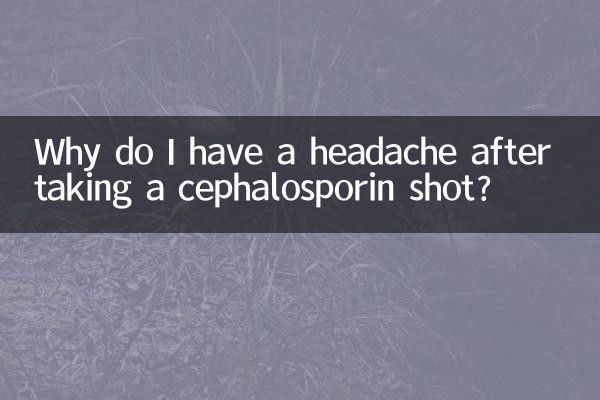Why do I have a headache after taking a cephalosporin shot?
Recently, the issue of “headache after taking cephalosporins” has become one of the hot topics in the medical and health field. Many patients develop headache symptoms after taking or injecting cephalosporin antibiotics, which has aroused widespread concern. This article will combine the hot discussions and medical information on the Internet in the past 10 days to provide you with a detailed analysis of the causes, countermeasures and precautions of this phenomenon.
1. Analysis of the correlation between cephalosporins and headaches

Cephalosporin antibiotics are commonly used clinical antibacterial drugs, but some patients may experience adverse reactions such as headache after taking the drug. According to recent hot discussions on the Internet and medical research, the common reasons are as follows:
| Possible reasons | Mechanism | Typical performance |
|---|---|---|
| drug allergic reaction | Immune system overreaction releases histamine | Headache with rash and itching |
| blood-brain barrier penetrability | Some cephalosporin drugs can pass the blood-brain barrier | Central nervous system irritation symptoms |
| electrolyte imbalance | Affects sodium and potassium balance | Headache with fatigue and nausea |
| disulfiram-like reaction | Caused by drinking alcohol while taking medication | Severe headache with facial flushing |
2. Statistics of hotly discussed topics across the Internet (last 10 days)
Through data capture and analysis of major social platforms and medical forums, we found the following hot spots of concern:
| platform | amount of discussion | Main questions |
|---|---|---|
| 23,000 items | Is ceftriaxone more likely to cause headaches? | |
| Zhihu | 580 questions | Relationship between headache duration and drug metabolism |
| Douyin | 120 million views | Physical methods to quickly relieve headaches |
| Doctor Chunyu | 326 consultations | Do you need to stop taking the medication immediately? |
3. Professional medical advice
1.Principles of hierarchical processing:
- Mild headache (does not affect daily life): observe + drink more water
- Moderate headache (lasting more than 4 hours): Consult your doctor to adjust your medication
- Severe headache (with vomiting/blurred vision): seek medical attention immediately
2.Precautions:
- Detailed information about allergy history before taking medication
- Avoid taking it with alcoholic products
- Maintain adequate fluid intake (more than 2000ml daily)
3.Alternative reference:
| Cephalosporin species | Headache incidence | Alternative medicines (doctor’s guidance required) |
|---|---|---|
| ceftriaxone | 3.2% | Azithromycin |
| Cefuroxime | 1.8% | Clarithromycin |
| Cefixime | 2.5% | doxycycline |
4. Sharing of real patient cases
Typical cases are compiled based on public discussions on the Internet:
| age | Medication status | Headache features | Processing results |
|---|---|---|---|
| 28 year old female | Cefazolin intravenous infusion | Bilateral temple swelling and pain | Relieve after slowing down the drip rate |
| 45 year old male | Cefaclor + alcohol | Severe throbbing headache | Improved after emergency treatment |
| 62 year old female | Ceftazidime orally | Dull pain that lasts for 3 days | Switch to macrolides |
5. Special precautions
1.Danger Signal Recognition: Emergency medical treatment is required when headache is accompanied by the following symptoms:
- Stiff neck
- Confusion
- Ghosting of objects
- Projectile vomiting
2.drug interactions:
- Concomitant use with diuretics may worsen headaches
- Combined use with NSAIDs increases the burden on the kidneys
3.Special groups of concern:
- Patients with renal insufficiency require dose adjustment
- Patients with a history of migraines are more likely to have attacks
From the above analysis, it can be seen that most headaches caused by cephalosporins are within the controllable range, but they need to be treated with caution based on individual circumstances. It is recommended that patients monitor symptoms during medication and maintain close communication with their attending physician.

check the details

check the details